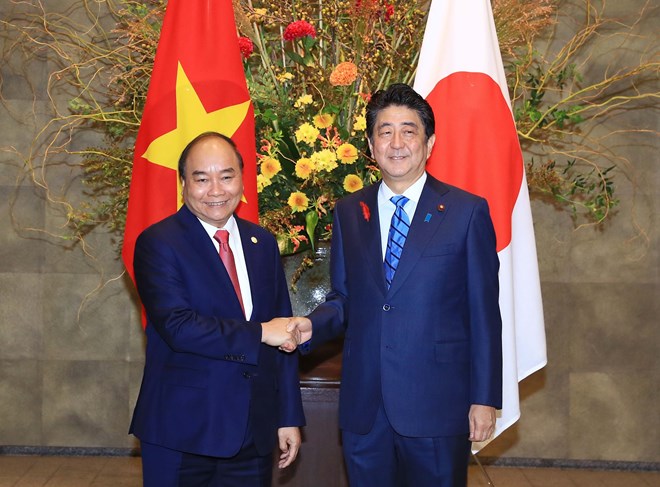



Japanese Prime Minister Shinzo Abe (R) welcomes Vietnamese PM
Nguyen Xuan Phuc in Tokyo on October 8 (Photo: VNA)
Over the past years, relations between Vietnam and Japan have been developing
rapidly and substantively in various spheres with high political trust.
Japan is the first G7 member to have welcomed a General Secretary of the
Communist Party of Vietnam (in 1995), set up the strategic partnership with
Vietnam (2009), recognised Vietnam’s market economy (2011), and invited the
country to an outreach meeting of a G7 Summit (2016).
In an official visit to Japan by then Party General Secretary Nong Duc Manh in
April 2009, the two countries agreed to lift their ties to the strategic
partnership for peace and prosperity in Asia.
During a trip to Vietnam by then Japanese PM Naoto Kan in October 2010, they
issued a joint statement on comprehensively developing the strategic
partnership for peace and prosperity in Asia.
In a State visit by then Vietnamese President Truong Tan Sang in March 2014,
the two sides elevated bilateral relations to the extensive strategic
partnership for peace and prosperity in Asia.
In the official tour of Japan in September 2015, Party General Secretary Nguyen
Phu Trong and Japanese PM Shinzo Abe issued a joint vision statement on Vietnam
– Japan relations.
Bilateral links have been enhanced even more strongly following a State visit
to the Southeast Asian nation by Japanese Emperor Akihito and Empress Michiko
from February 28 to March 5, 2017, and an official trip by PM Abe in January
2017.
The countries have effectively maintained dialogue mechanisms and supported
each other at multilateral forums like the United Nations, the Association of
Southeast Asian Nations (ASEAN), the Asia-Pacific Economic Cooperation (APEC),
and the Asia – Europe Meeting (ASEM).
Japan is currently a leading economic partner of Vietnam. It is the biggest
provider of official development assistance (ODA) for and ranks second among
foreign investors in Vietnam. Last year, it was the fourth largest trade
partner of Vietnam.
In the first eight months of 2018, bilateral trade reached 24.52 billion USD
(up 13.7 percent year on year), in which Vietnam’s exports were worth 12.21
billion USD of (up 11.5 percent) and the country’s imports from Japan were
valued at 12.31 billion USD (up 15.9 percent).
In 2017, Japan’s direct investment in Vietnam hit a record of 9.11 billion USD,
ranking first among countries and territories investing in the latter. By the
end of last August, it had 3,865 valid FDI projects worth nearly 55.84 billion
USD here, holding the second place.
Regarding ODA provision, the Northeast Asian nation pledged about 30.5 billion
USD in ODA loans for Vietnam from 1992 to the end of fiscal year 2016 (March
31, 2017). In the first half of this year, the two sides signed documents on
two projects to be funded through non-refundable aid with total value of nearly
25 million USD. Japan has also committed a loan worth almost 16 billion JPY
(142 million USD) for vocational training in Vietnam.
Meanwhile, agricultural cooperation has witnessed breakthroughs since the State
visit to Japan by then President Truong Tan Sang in 2014. During the trip by
Party General Secretary Nguyen Phu Trong in September 2015, both sides inked
the long-term joint vision on agricultural cooperation. A revised version of
the joint vision was signed in May this year.
Vietnam has sent a large number of apprentices to Japan since 1992, raising the
number of Vietnamese workers and apprentices there to about 120,000 at present.
Cooperation in education and training has been expanded in various forms. Japan
is one of the biggest suppliers of non-refundable aid in education for Vietnam.
As of the beginning of this year, there were about 75,000 Vietnamese students
in Japan. The G7 nation is also assisting Vietnam in upgrading four
universities, developing the Vietnam Japan University, and teaching Japanese at
some schools in Hanoi and Ho Chi Minh City.
In the first 7 months of this year, nearly 464,400 Japanese tourists visited
Vietnam, rising by 3 percent from a year earlier and ranking third among
foreign holidaymakers in the ASEAN country.
Additionally, locality-to-locality connections have been strongly promoted.
Many pairs of localities of the two countries have inked cooperation deals such
as HCM City and Osaka city, Yokohama city and Nagano prefecture; Da Nang city
and Sakai and Yokohama cities; Hanoi and Fukuoka prefecture; and Dong Nai
province and Hyogo prefecture.
Source: VNA